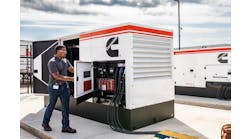Two pitfalls to avoid when selecting batteries for your industrial microgrid
The need for a resilient source of power is becoming increasingly important for industrial facilities. As they face growing threats from wildfires, natural disasters and a host of other factors impacting the grid, more organizations are looking for a way to keep the power flowing.
How microgrids provide resilience
Microgrids provide resilience when there’s a grid outage by switching or transitioning to what’s called island mode operation. Simply put, the microgrid’s controller senses the loss of grid power, disconnects from the grid and switches to on-site distributed energy resources (DERs). DERs used by industrial facilities can include renewable generation sources such as solar PV and a battery energy storage system, with the potential to use nonrenewable generation such as diesel generators as a backup where required to extend the run time of the battery system.
Island mode is appealing because it can, when correctly designed, provide a seamless transition from the grid when there’s an unplanned outage and then a seamless transition back to the grid when power is restored. All of this is done in milliseconds and with minimal disruption to operations. That said, transitioning to island mode can be fraught with issues if you don’t have the right batteries in your BESS.
Here are two key questions that organizations should ask about when developing the BESS for their industrial microgrid:
1. Which parts of our facility will we transition to island mode?
First, if you want to ensure your microgrid will deliver a seamless transition to island mode, you must understand not only the load of your critical components but also your peak load.
Consider this scenario: To keep critical operations running, a food processor in California needs 1.7 MW of power. When they design their microgrid, they plan to install solar PV and a 2-MW battery to support that critical infrastructure in island mode. But here’s the problem — their peak load, which can be at any time of day, is actually 10 MW. If there’s an unplanned grid outage while they’re at their peak load, the microgrid controller will transition the entire 10 MW to their 2-MW battery and their solar panels. If the panels aren’t generating the additional 8 MW of electricity needed, the system will trip. There would be no seamless transition, and those critical components would have to be restarted. The reality here is that you cannot subject the battery to more than 100% to 110% of its MW rating depending on the converter capability.
This leads to some design options:
- Ensure the BESS is specified to meet the peak demand, which could be much more expensive especially where the difference between critical load demand and peak demand is large.
- Adopt a nonseamless transition to an island mode microgrid. With this option, there will be a temporary supply outage while the electricity distribution network circuit breakers are configured to isolate the noncritical loads and then energize the network with the critical loads from a suitably specified battery system with other DERs then introduced. This is commonly referred to as a microgrid black start scenario. This option depends on the impacts a loss of grid supply has on the industrial process including commercial and safety impacts. While the loss of supply may be short, alternative arrangements such as a UPS [uninterruptible power supply], which may be a battery-based system, may be required to maintain supply to critical loads during this short period. However, where critical loads are much smaller compared with peak demand, this would avoid the need for a microgrid forming BESS rated for peak demand.
It is noted that options to avoid subjecting a BESS rated for critical load demand with larger peak demand on a loss of grid using fast intertripping schemes would be problematic. This would require very fast loss of grid detection systems that can also isolate the noncritical loads from the critical loads and needs to be completed before the battery system protection operates, typically in 100 to 200 milliseconds. Loss of detection in the short time scales required would not differentiate between genuine loss of grid conditions and temporary grid supply fluctuations, resulting in unnecessary transitions to island microgrid operations and loss of supply to noncritical loads.
2. Will my battery support my industrial microgrid?
Second, to support an islanded microgrid, your battery must have a certain set of features. In the past, when organizations relied solely on diesel generators for their backup power, it was the generator’s frequency governor and voltage regulator that maintained stable power. Today, it’s the software in the BESS. The challenge is that not all batteries have appropriate software controls to provide that regulation, which means that some batteries just can’t control an islanded microgrid.
There are two key battery features to consider. Grid following batteries, as the name suggests, follow the frequency of the grid and don’t have the ability to set and regulate frequency on their own. Clearly this is a problem if there’s a grid outage and thus no frequency source from the grid to follow. Grid forming batteries, on the other hand, can set and regulate both frequency and voltage. For grid/microgrid operations, BESS batteries must have software that supports both grid following and grid forming mode as well as the ability to switch between these modes.
It’s also critical to note that you need to work with a vendor that can supply batteries that support seamless transition from the grid to the BESS because not all grid forming batteries can.
Taking the time to understand the features and capabilities of your batteries during the design phase of your industrial microgrid project will save you countless hours and headaches down the road.
Colin MacKenzie is principal consultant at Smarter Grid Solutions.








